Amelanchier arborea
,
Deciduous
Origin:
Native to eastern US and eastern Nebraska
Downy serviceberry is a small forest understory tree native to much of the eastern US and reaching its western limit in southeast
Nebraska along the Missouri River. It is occasionally used as a landscape ornamental.

Where To Grow
Serviceberry prefers moist, acidic, rich soils, but can tolerate a wide range of conditions except severe drought. It is shade tolerant
and can be used in shrub borders, foundation plantings or in woodland/naturalized gardens, especially with dark or shaded backdrops
which tend to highlight the form, flowers and fall color of the plant. Also effective along stream banks and ponds.
Suitable to plant east of the 100th meridian.
Size at Maturity
Tree Height
Tree Spread
15-20'
15-20'
Wildlife Benefits
In natural sites, early summer fruits are relished by birds and mammals, while the thick canopy is a frequent nesting site for small
birds.
Utilization
These delicious berries resemble blueberries in size and color and are often used in jams, jellies, and pies. There are some
interesting beverages that can also be
created!
Serviceberry Jelly
3.5 cups serviceberry juice*
2 tbsp lemon juice
6 tbsp pectin
5 cups granulated sugar**
Pour the serviceberry juice and lemon juice in a large stainless steel pan and stir to combine.
Add the pectin to the pan and stir until dissolved.
Bring the pan to a rolling boil over high heat.
Add the sugar, then return to a rolling boil, stirring constantly for 1 minute until sugar dissolves.
Remove from the heat and skim off any foam from the top.
Pour the jam into sterilized jars, leaving 1/4 inch of headspace and then process in a boiling water bath canner for 15
minutes.
*Cherry juice is a tasty substitute if you aren't able to collect enough serviceberry
** We prefer a more natural (tart) taste. We recommend reducing the sugar by at least one-third
Additional Considerations
Serviceberry can be grown in full sun but does best with some late afternoon shade. Mildews and rusts can deform the fruits in wet years.
Birds love the fruits and often pick the tree clean almost immediately after they ripen. Bird netting can be used to prevent this.
Related species
There are several species of serviceberry native to North America. Some that can be grown in Nebraska include:
Allegheny serviceberry (Amelanchier laevis) is a northeast US native and very similar to downy serviceberry.
Apple serviceberry (Amelanchier x grandiflora) is a hybrid between downy serviceberry and Allegheny
serviceberry with several cultivars on the market including the fairly common ‘Autumn Brilliance’, selected for its brilliant
orange-red fall color.
Saskatoon serviceberry (Amelanchier alnifolia) is native to much of the northwest US and Canada and is native
to northern Nebraska along the Niobrara River. It is typically a shrubby species and is cultivated for its large sweet fruits.
Interesting Facts
The common name “downy” refers to the downy hairs on its winter buds. Serviceberries are known to be several common names including
shadbush (because they often bloom when shad fish are spawning), and Juneberry because the fruits often ripen in June.


